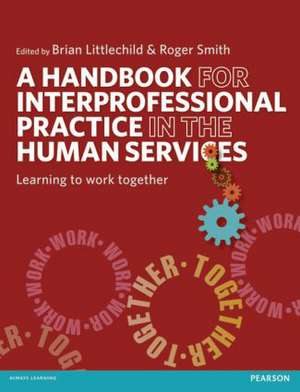A Handbook for Interprofessional Practice in the Human Services: Learning to Work Together
Editat de Brian Littlechild, Roger Smithen Limba Engleză Paperback – 14 sep 2012
With an emphasis on working collaboratively with fellow professionals, service users and the community, and developing an holistic approach to working, this is an essential resource for anyone studying on courses in social work, nursing, education, health, medicine, social policy, physiotherapy, occupational therapy, physiotherapy and dentistry, and for all those with an interest in the human services.
Preț: 313.50 lei
Nou
Puncte Express: 470
Preț estimativ în valută:
59.100€ • 62.41$ • 49.53£
59.100€ • 62.41$ • 49.53£
Carte disponibilă
Livrare economică 24 martie-07 aprilie
Livrare express 07-13 martie pentru 40.22 lei
Preluare comenzi: 021 569.72.76
Specificații
ISBN-13: 9781408224403
ISBN-10: 1408224402
Pagini: 350
Dimensiuni: 189 x 246 x 18 mm
Greutate: 0.65 kg
Ediția:New.
Editura: Taylor & Francis
Colecția Routledge
Locul publicării:Oxford, United Kingdom
ISBN-10: 1408224402
Pagini: 350
Dimensiuni: 189 x 246 x 18 mm
Greutate: 0.65 kg
Ediția:New.
Editura: Taylor & Francis
Colecția Routledge
Locul publicării:Oxford, United Kingdom
Cuprins
Brief contents
Contributors
Author acknowledgements
Publisher’s acknowledgements
INTRODUCTION
Part One KEY ISSUES IN INTERPROFESSIONAL AND INTERAGENCY WORKING IN HEALTH AND SOCIAL CARE
1 Working together: why it’s important and why it’s difficult
2 The drivers and dynamics of interprofessional working in policy and practice
3 Change and challenge in interprofessional education
4 Keeping interprofessional practice honest: fads and critical reflections
5 Working in partnership to develop local arrangements for interagency and interprofessional services: a case study
6 Information-sharing agreements between agencies and professionals: making use of law, policy and professional codes
Part Two INTERPROFESSIONAL AND INTERAGENCY WORKING WITH DIFFERENT SERVICE-USER GROUPS
7 Mental health
8 Learning disabilities
9 Safeguarding and child protection
10 Children in need and looked-after children
11 Older people
12 End of life care
13 Rehabilitation and disabled people
Part Three INTERPROFESSIONAL AND INTERAGENCY WORKING: SERVICE USERS, CARERS AND DIFFERENT PROFESSIONAL GROUPS
14 Service user issues: rights, needs and expectations
15 Member of the team? Carers experience of interprofessional working, key issues in current policy and practice
16 The barriers presented by power, control and agency agendas on carer participation in interprofessional working: promoting inclusionary practice
17 Teachers and education
18 Doctors and medicine
19 Occupational therapists
20 Social workers
21 Physiotherapists
22 Nurses
23 Pharmacists
24 Dentists
Index
Contributors
Author acknowledgements
Publisher’s acknowledgements
INTRODUCTION
Part One KEY ISSUES IN INTERPROFESSIONAL AND INTERAGENCY WORKING IN HEALTH AND SOCIAL CARE
1 Working together: why it’s important and why it’s difficult
2 The drivers and dynamics of interprofessional working in policy and practice
3 Change and challenge in interprofessional education
4 Keeping interprofessional practice honest: fads and critical reflections
5 Working in partnership to develop local arrangements for interagency and interprofessional services: a case study
6 Information-sharing agreements between agencies and professionals: making use of law, policy and professional codes
Part Two INTERPROFESSIONAL AND INTERAGENCY WORKING WITH DIFFERENT SERVICE-USER GROUPS
7 Mental health
8 Learning disabilities
9 Safeguarding and child protection
10 Children in need and looked-after children
11 Older people
12 End of life care
13 Rehabilitation and disabled people
Part Three INTERPROFESSIONAL AND INTERAGENCY WORKING: SERVICE USERS, CARERS AND DIFFERENT PROFESSIONAL GROUPS
14 Service user issues: rights, needs and expectations
15 Member of the team? Carers experience of interprofessional working, key issues in current policy and practice
16 The barriers presented by power, control and agency agendas on carer participation in interprofessional working: promoting inclusionary practice
17 Teachers and education
18 Doctors and medicine
19 Occupational therapists
20 Social workers
21 Physiotherapists
22 Nurses
23 Pharmacists
24 Dentists
Index
Descriere
A Handbook for Inter-professional Practice in the Human Services: Learning to Work Together is an essential text for all students of inter-professional education, and for practitioners looking to understand and develop better inter-agency working.
With an emphasis on working collaboratively with fellow professionals, service users and the community, and developing an holistic approach to working, this is an essential resource for anyone studying on courses in social work, nursing, education, health, medicine, social policy, physiotherapy, occupational therapy, physiotherapy and dentistry, and for all those with an interest in the human services.
It provides uniquely comprehensive coverage and wide-ranging analysis of the key issues within and across the different human services. Expert chapters from contributors in key areas such as health and social care services, education and school services, offender services, children’s services, and continuing care give insights into the challenges of collaborative working and the contexts in which these challenges may be faced. Contributions from service users, and carers’ perspectives highlight their fundamental role in the inter-agency team. With examples from distinct service areas, students and practitioners are able to explore their own area of work whilst also gaining an understanding of issues faced by other professionals.
With an emphasis on working collaboratively with fellow professionals, service users and the community, and developing an holistic approach to working, this is an essential resource for anyone studying on courses in social work, nursing, education, health, medicine, social policy, physiotherapy, occupational therapy, physiotherapy and dentistry, and for all those with an interest in the human services.
It provides uniquely comprehensive coverage and wide-ranging analysis of the key issues within and across the different human services. Expert chapters from contributors in key areas such as health and social care services, education and school services, offender services, children’s services, and continuing care give insights into the challenges of collaborative working and the contexts in which these challenges may be faced. Contributions from service users, and carers’ perspectives highlight their fundamental role in the inter-agency team. With examples from distinct service areas, students and practitioners are able to explore their own area of work whilst also gaining an understanding of issues faced by other professionals.











